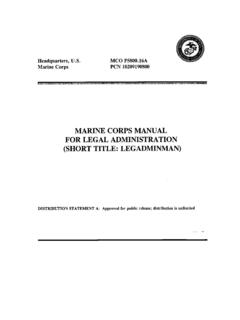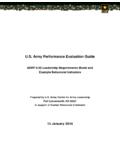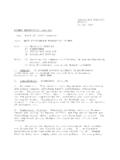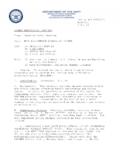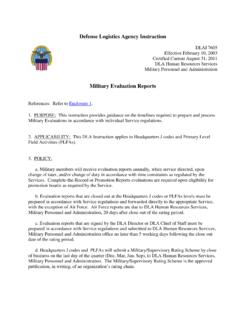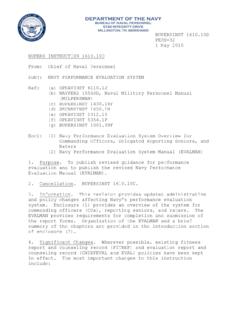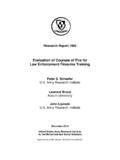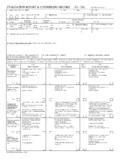Transcription of Personnel Evaluation Evaluation Reporting System
1 Army Regulation 623 3. Personnel Evaluation Evaluation Reporting System Headquarters Department of the Army Washington, DC. 10 August 2007. UNCLASSIFIED. SUMMARY of CHANGE. AR 623 3. Evaluation Reporting System This rapid action revision, dated 10 August 2007-- o Updates all references to the OER Senior Rater Profile to reflect consolidation of profiles from three (separated by grade and component of rated officer) to one (separated by grade of rated officer). Consolidation impacts the answer to the senior rater question in Part (para 3-11) and senior rater assessment made in Part After consolidation, OER. information will reflect in a single Senior Rater Profile Report for each senior rater and in all applications reflecting administrative information (para 3-12). o Adds the Evaluation Timeliness Report as a second section, with two sub- sections, of the Senior Rater Profile, regardless of the senior rater's status as an OER senior rater. The Evaluation Timeliness Report compiles information on timeliness of OER and NCOER submissions and ties it to individual senior raters.
2 This report is authorized for placement in individual Official Military Personnel Files (para 3-12). o Changes the time requirements for submission to HQDA for all military evaluations (OER, NCOER, and AER) to receive at HQDA within 90 days after the THRU date on the report (para 3-37). o Changes the mailing address for submission to HQDA for all OER to the address previously used for only Active Army OER (app F). o Fixes several administrative errors (throughout). This new regulation, dated 15 May 2006-- o Removes Personnel Services Battalion functions from processing requirements and no longer requires its initials on a final DA Form 67-9 or DA Form 2166-8. o Updates appendix E covering Army Medical Department officer Evaluation reports. o Throughout the document, clarifies when a report is considered completed at the unit level and final processing at Headquarters, Department of the Army. o Retains Evaluations Reporting System policy in the regulation and moves procedures into DA Pamphlet 623-3.
3 O Streamlines and coordinates policy among DA Forms 67-9 (Officer Evaluation Report), 2166-8 (NCO Evaluation Report), and 1059 (Service School Academic Evaluation Report) (para 1-1). o Updates process for changing evaluations policy from an automated and rigid stepped System of policy relaxation based on mobilization phases to a more flexible process, as contained in the appropriate Personnel policy guidance (para 1-13). o Changes DA Form 1059 processing (chap 2, sec II, and paras 3-37, 3-52). o Changes requirements for rating officials (paras 2-4 and 2-19). o Changes policy on specific assessment items and report types (paras 3-2b(1), 3-2g(1), 3-4, 3-13 3-58). o Maintains the noncommissioned officer Evaluation report counseling philosophy, but redesigns the counseling form and process (para 3-4). o Adds to and changes administrative information and layout on DA Forms 67-9 and DA Form 2166-8 and the support forms (para 3-3). o Requires that safety objectives and/or tasks be developed for every officer and noncommissioned officer as one element of the support form/counseling requirements (para 3-4c(5)(d)(3)).
4 O Changes administrative information on both AERs (DA Form 1059 and DA Form 1059-1 (Civilian Institution Academic Evaluation Report)) (paras 3-35, 3- 36). o Maintains basic Evaluation philosophy from previous regulations and accommodates new systems for collecting and delivering Evaluation content from and among organizational users and Headquarters, Department of the Army (para 3-37). o Accommodates capabilities of a new forms method (producing and routing), the Forms Content Management Program (para 3-37). o Adds requirement to use only forms and forms creation applications or programs authorized by Army Publishing Directorate (para 3-37). o Changes the noncommissioned officer Evaluation process (paras 3-37f(2) and (3)). o Provides a process for use of electronic approvals (digital signatures) using applications approved for the Army by Army Publishing Directorate in forms templates and forms producing applications (para 3-37f(7)(b)). o Removes Academic Evaluation Reports (DA Form 1059 and DA Form 1059-2) from an individual's Evaluation history (para 3-52).
5 Headquarters *Army Regulation 623 3. Department of the Army Washington, DC. 10 August 2007 Effective 10 September 2007. Personnel Evaluation Evaluation Reporting System otherwise stated. Also, it applies to De- This regulation contains management con- partment of the Army civilians, military trol provisions, but does not identify key members and civilians of other management controls that must be Armed Forces, other Government of- evaluated. ficials, and allied forces that function as rating officials. This regulation applies Supplementation. Supplementation of during mobilization in conjunction with this regulation and establishment of com- Personnel Policy Guidance published for mand and local forms are prohibited with- each operation and issued by Headquar- out prior approval from the Deputy Chief ters, Department of the Army. of Staff, G 1 (DAPE ZA), Washington, Proponent and exception authority. DC 20310 0300. The proponent of this regulation is the Suggested improvements.
6 Users are Deputy Chief of Staff, G 1. The propo- nent has the authority to approve excep- invited to send comments and suggested tions or waivers to this regulation that are improvements on DA Form 2028 (Recom- consistent with controlling law and regu- mended Changes to Publications and History. This publication is a rapid action lations. The proponent may delegate this Blank Forms) directly to Commander, U. revision. The portions affected by this approval authority, in writing, to a divi- S. Army Human Resources Command rapid action revision are listed in the sion chief within the proponent agency or (AHRC MSE), 200 Stovall Street, summary of change. a direct Reporting unit or field operating Alexandria, VA 22332 0442. Summary. This regulation prescribes the agency, in the grade of colonel or the civilian equivalent. Activities may request Distribution. This publication is availa- policies and tasks for the Army's Evalua- ble in electronic media only and is in- tion Reporting Systems.
7 These include a waiver to this regulation by providing justification that includes a full analysis of tended for command levels A, B, C, D, Reporting systems for officers and non- commissioned officers and academic per- the expected benefits and must include a and E for the Active Army, the Army formance and potential. It includes policy formal review by the activity's senior National Guard/Army National Guard of statements, operating tasks, and rules in legal officer. All waiver requests will be the United States, and the Army support of operating tasks. endorsed by the commander or senior Reserve. leader of the requesting activity and for- Applicability. This regulation applies to warded through their higher headquarters the Active Army, the Army National to the policy proponent. Refer to AR. Guard/Army National Guard of the United 25 30 for specific guidance. States, and the Army Reserve, unless Army management control process. Contents (Listed by paragraph and page number).
8 Chapter 1. Introduction, page 1. Section I. Overview, page 1. Purpose 1 1, page 1. References 1 2, page 1. Explanation of abbreviations and terms 1 3, page 1. Responsibilities 1 4, page 1. Manpower resources 1 5, page 2. *This regulation supersedes AR 623 3, dated 15 May 2006. AR 623 3 10 August 2007 i UNCLASSIFIED. Contents Continued Levels of work 1 6, page 2. Section II. Principles and Standards, page 2. Principles of support 1 7, page 2. Standards of service 1 8, page 2. Section III. Special Circumstances, page 5. Performance and potential evaluations 1 9, page 5. Changes to an Evaluation report 1 10, page 5. Commander's/Commandant's Inquiry 1 11, page 5. Access to reports 1 12, page 5. Mobilization 1 13, page 5. Privacy Act statement 1 14, page 5. Chapter 2. The Rating Chain, page 6. Section I. Managing the Rating Chain, page 6. Overview 2 1, page 6. Fundamentals 2 2, page 6. Rating chain information 2 3, page 6. General rules for establishing rating chains 2 4, page 6. Section II.
9 Rating Chain Development and Maintenance, page 7. Rules for designating a rater 2 5, page 7. Rules for designating an officer Evaluation report intermediate rater 2 6, page 9. Rules for designating a senior rater 2 7, page 9. Rules for designating a reviewer 2 8, page 10. Steps for rating chain development and maintenance 2 9, page 10. Section III. The Role of Rating Chain Members, page 11. The rated individual 2 10, page 11. Role of the rated officer selected for promotion 2 11, page 11. Role of the rater 2 12, page 12. Additional role for raters 2 13, page 12. Role of the intermediate rater (DA Form 67 9 only) 2 14, page 12. Role of the senior rater or authenticating official 2 15, page 13. Additional roles for senior raters 2 16, page 13. Section IV. Evaluation Reviews, page 14. Review of noncommissioned officer reports 2 17, page 14. Review of officer and academic Evaluation reports 2 18, page 16. Mandatory review of officer relief reports 2 19, page 17. Section V. Special Evaluation Requirements, page 18.
10 Loss of a rating chain member 2 20, page 18. Supervisor as both rater and senior rater 2 21, page 19. Dual supervision (DA Form 67 9 only) 2 22, page 19. Professors of military science 2 23, page 20. ii AR 623 3 10 August 2007. Contents Continued Special requirements 2 24, page 20. Chapter 3. Army Evaluation Principles, page 20. Section I. Evaluation Overview, page 20. Introduction 3 1, page 20. Evaluation requirements 3 2, page 20. Section II. Evaluation support forms, page 21. Evaluation forms 3 3, page 21. The support form communication process 3 4, page 21. Role of the rated individual 3 5, page 22. Role of the rater 3 6, page 23. Role of the intermediate rater 3 7, page 24. Role of the senior rater 3 8, page 24. Section III. Officer Evaluation Report Assessments, page 25. Rater assessments 3 9, page 25. Intermediate rater assessments 3 10, page 25. Senior rater assessments 3 11, page 25. Senior Rater Profile Report (DA Form 67 9 2) 3 12, page 26. Senior rater profile restarts 3 13, page 26.
